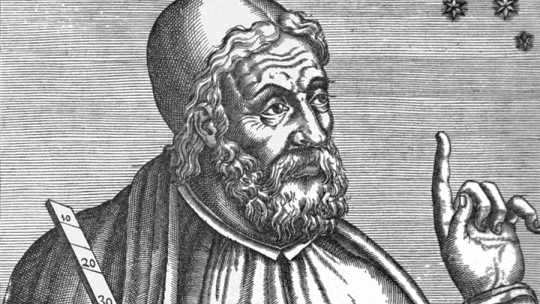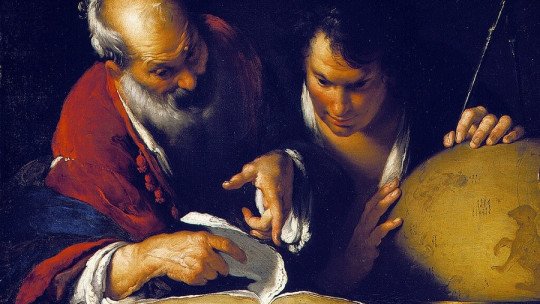
Classical Antiquity was a turbulent time but, at the same time, full of new advances and such significant development of science that, if it had not been for the Middle Ages, we would surely have come much further than where we are now.
Although the majority of the population was illiterate and uneducated, there were many great men who lived at that time, among them Archimedes, a great mathematician, physicist and inventor of gadgets for civil and, above all, military purposes.
Below we will see the life and great contributions to science of this researcher through this biography of Archimedes, and we will better understand how the bases emerged, although primitive, of what, with the passage of almost 2000 years, would be our modern scientific method.
Archimedes of Syracuse: biography and contributions to science
Archimedes was a mathematician, physicist, inventor, engineer and astronomer who lived in the times of Ancient Greece about 2000 years ago. At that time, few people had the privilege of knowing how to read and write, so there are not many writings about him and everything we know about this inventor is from oral tradition and testimonies from several classical writers, most of them later. to Archimedes.
His homeland was Syracuse, a city that was located in Magna Graecia, a region located on the island of Sicily and the south of the Italian peninsula The ruler of that city, who governed it as a tyrant, was Hiero II, who is suspected of being related in one way or another to Archimedes. Whatever their relationship, the two had a very interesting relationship, since Herion II trusted the mathematician to be an advisor and inventor for the defense of the city.
We know little about Archimedes’ family. Not much is known about his mother, but we do know about his father Phidias, an astronomer who transmitted to her his interest in the science of the sky. It does not appear that he married or had children, and if he did have them, he was erased from the annals of history. We also cannot confirm if he said his famous “eureka” while walking naked through the streets of his hometown, nor if he really said the phrase “give me a foothold and I will move the world.”
Early years
Archimedes was born in 287 BC in Syracuse, Sicily. Thanks to a fragment of his book “The Sand Counter” we know that his father’s name was Phidias and that he was a well-known astronomer of the time. Seeing that his son showed great abilities from a very young age, Phidias decided to introduce him to the world of mathematics and astronomy.
Thanks to his great aptitudes and his good relationship with the king of Syracuse Hiero II Archimedes was sent to Alexandria in 243 BC, the center of science at the time, in order to expand his knowledge in mathematics under the teaching of the eminences of the time. Among his teachers was Canon of Samos, a great mathematician from whom the young Archimedes learned a lot. After his stay in the Egyptian city, Archimedes returned to his homeland to begin his research.
Service for the country
Upon his return from Alexandria Archimedes He was accepted as an advisor to Hiero II, in charge of designing systems and gadgets that would help the defense of the city Under the protection and patronage of the monarch, the young mathematician had complete freedom to do all kinds of experiments, as long as they benefited the king and Syracuse. Having Hiero II as his patron, Archimedes would begin an era of extensive research and great advances.
One of the most important episodes of this time for his career was when the king ordered the construction of the largest boat ever manufactured, with such bad luck that, when he put it into the sea, it ran aground. Since not even brute force could remove the ship, Hiero II commissioned Archimedes to find ways to refloat the ship. Thus, Archimedes devised a system of compound pulleys that increased the thrust force, moving the ship with little effort, laying the foundations for his law of the lever.
Another of the most important moments in Archimedes’ life was when the king asked him to resolve a doubt that was keeping him up at night. The monarch wanted to know if his crown was really made of solid gold or if he had been deceived and its interior was made of a less valuable material This problem turned out to be a real headache for Archimedes, since he did not know how to solve this issue without breaking the crown in two and seeing inside.
The Greek scientist knew that he had to find the density of the crown and, taking into account that it weighed the same as a gold ingot, the answer had to be found in its volume. The problem was that there was no known way at the time to calculate the volume of irregular objects. Legend has it that he discovered how to do it while he was bathing. As he immersed himself in the bathtub he saw that the water level was rising. The amount of water that rose was directly proportional to the volume of the body that was submerged.
From this he concluded that, If he submerged the crown and measured the variation in the water level he could know precisely what its volume was This was one of his great discoveries and, for this reason, it was known as Archimedes’ principle. It is said that, upon such a discovery, he emerged from the bathtub euphoric shouting “eureka”, naked through the streets of Syracuse before the surprised gaze of passers-by.
Conflict in Syracuse
During the year 213 BC Roman soldiers attacked Syracuse and harassed its inhabitants into surrender This action was led by Marcus Claudius Marcellus, a distinguished Roman soldier and politician baptized as the Sword of Rome, a key figure in the Second Punic War. The war lasted two years, in which the inhabitants of Syracuse fought against the Romans with courage, tenacity and fierceness, among them Archimedes who played a very important role in the defense of the city.
But unfortunately the city ended up falling. Marcus Claudius Marcellus, who knew of Archimedes’ great intellectuality, explicitly ordered that he not be harmed or killed, since he wanted him among his advisors. However, Whether due to the ignorance or ineptitude of his own subordinates, Archimedes died at the hands of one of the Roman soldiers in 212 BC There are four versions of what happened.
The four deaths of Archimedes
One version says that Archimedes was in the middle of solving a mathematical problem when the Roman soldier approached him. The mathematicianHe asked for a little time to solve the problem and the soldier must not have liked that who decided to end his life.
Another version says that Archimedes was solving a mathematical problem when Syracuse was taken. A Roman soldier entered his compound and ordered him to meet with Marcellus, to which the mathematician replied that he wanted to solve the problem he was working on. The soldier, upset by the answer, murdered Archimedes, disobeying Marcellus.
There is a third version that says that Archimedes had a lot of mathematical instruments in his hands. The soldier He saw him, thinking he must be carrying valuables or some kind of weapon to defeat the Roman invaders, so without thinking twice he ended the life of the mathematician.
Finally, the fourth and most realistic version says that Archimedes was crouched on the ground, contemplating one of his plans. While he was studying him, a Roman soldier approached him from behind, Not knowing that it was the Greek genius, he decided to shoot him in the back
After his death
Having passed more than 130 years after his death, in the year 137 BC the Roman writer, politician and philosopher Marcus Tullius Cicero occupied a position in the administration of Rome and wanted to find the tomb of Archimedes It was not easy for him, since Cicero did not find anyone to tell him the precise place where the mathematician had been buried.
Despite the unknowns and total ignorance about where Archimedes’ remains were located, Cicero managed to locate the tomb, very close to the gate of Agrigento. His resting place was in a deplorable condition, so Cicero decided to clean his tomb and, to his surprise, found that It was inscribed on a sphere inside a cylinder, alluding to one of his discoveries
Contributions to science
Although the passage of time and the darkness of the Middle Ages meant that much knowledge from Antiquity was lost forever, there are many pieces of knowledge attributed to Archimedes that have managed to reach the present day. Among the most notable we have the following:
1. Archimedes Principle
Archimedes’ principle is, surely, the most famous and important legacy of the Greek Completely accidentally, Archimedes discovered a way to calculate the volume of any object, whether or not it had a regular shape.
This principle states that any body immersed, partially or totally in a fluid (liquid or gas) receives an upward thrust equal to the weight of the fluid displaced by the object. That is, depending on the volume of the object, the fluid will rise more or less, regardless of the weight of the object itself.
This principle not only allowed us to know the volume of any object but also It was key to perfecting the flotation of ships, life preservers, submarines and hot air balloons inventions that, although much later than Archimedes, would not exist without his discoveries.
2. Lever principle
Before modern cranes were invented to move heavy objects it was necessary to use brute force. Constructing buildings was a labor-intensive task and was sometimes impossible to construct due to lack of men.
Fortunately, Archimedes found the solution using one of the most basic and fundamental principles of physics and mechanics He observed that by placing an object on one end of a board properly balanced with a fulcrum, anything could be moved with relative effort.
3. Advances in mathematics
There are many mathematical advances that are attributed to the figure of Archimedes. Among them are precisely calculating the number Pi, making the first approximations to the infinitesimal calculus system and discovering that the relationship between the volume of a sphere and the cylinder in which it is located is 2:3, something that was represented in this way. his grave in his honor.
4. Mechanical method
Another of the most interesting contributions of Archimedes was the inclusion of a purely mechanical method in the reasoning and argumentation of geometric problems, something unheard of at its time. Until then, geometry was considered a purely theoretical science and it was common to think that pure mathematics descended into other more practical sciences that could be more useful for war and civil purposes.
Archimedes, in a writing addressed to his friend Eratosthenes, indicates that with his mechanical method he can address mathematical questions through mechanics. He also indicates that it is easier to construct the proof of a geometric theorem if one has prior practical knowledge rather than hypothesizing theoretically. This new research method would be the precursor of the informal stage of discovery and formulation of hypotheses typical of the current scientific method
5. The odometer
As surprising as it may seem, Archimedes invented the first odometer. Known as odometer It was a device built based on the principle of a wheel that, when it rotates, activates gears that allow you to calculate the distance traveled.
6. The first planetarium
Based on what was said by many classical writers, including Cicero, Ovid, Claudian, Marcianus Capela, Cassiodorus, Sextus Empiricus and Lactantius, it is considered that Archimedes invented the first planetarium.
He probably built two, according to Cicero One of them represented the Earth and several constellations close to it, while another, which only had one rotation, represented the Sun, the Moon, the planets that carried out their own and independent movements in relation to the fixed stars.
7. Archimedes’ screw
Archimedes invented a screw that allowed water to be transported from bottom to top across a slope According to Diodorus, this invention facilitated irrigation in the fertile lands of the Nile River in ancient Egypt, since traditional tools involved mobilizing a lot of human effort.
This cylinder had inside a screw of the same length that kept interconnected a system of propellers that carried out a rotary movement manually driven by a rotating lever. Thus, the propellers were able to push any substance from the bottom up, forming a kind of endless circuit.
8. Archimedes’ claw
Archimedes’ claw, also called the iron hand, It was one of the most fearsome weapons of war created by the mathematician, crucial in the defense of Sicily against the Roman invasions.
It was a large lever that had a grappling hook attached to the lever by a chain hanging from it. Through this lever the hook was manipulated so that it rushed towards the enemy ship, hooking it and causing it to either capsize or crash against the rocks on the shore.








